Your cart is currently empty!
Gustav Klimt : An Emotional Journey Through His Life
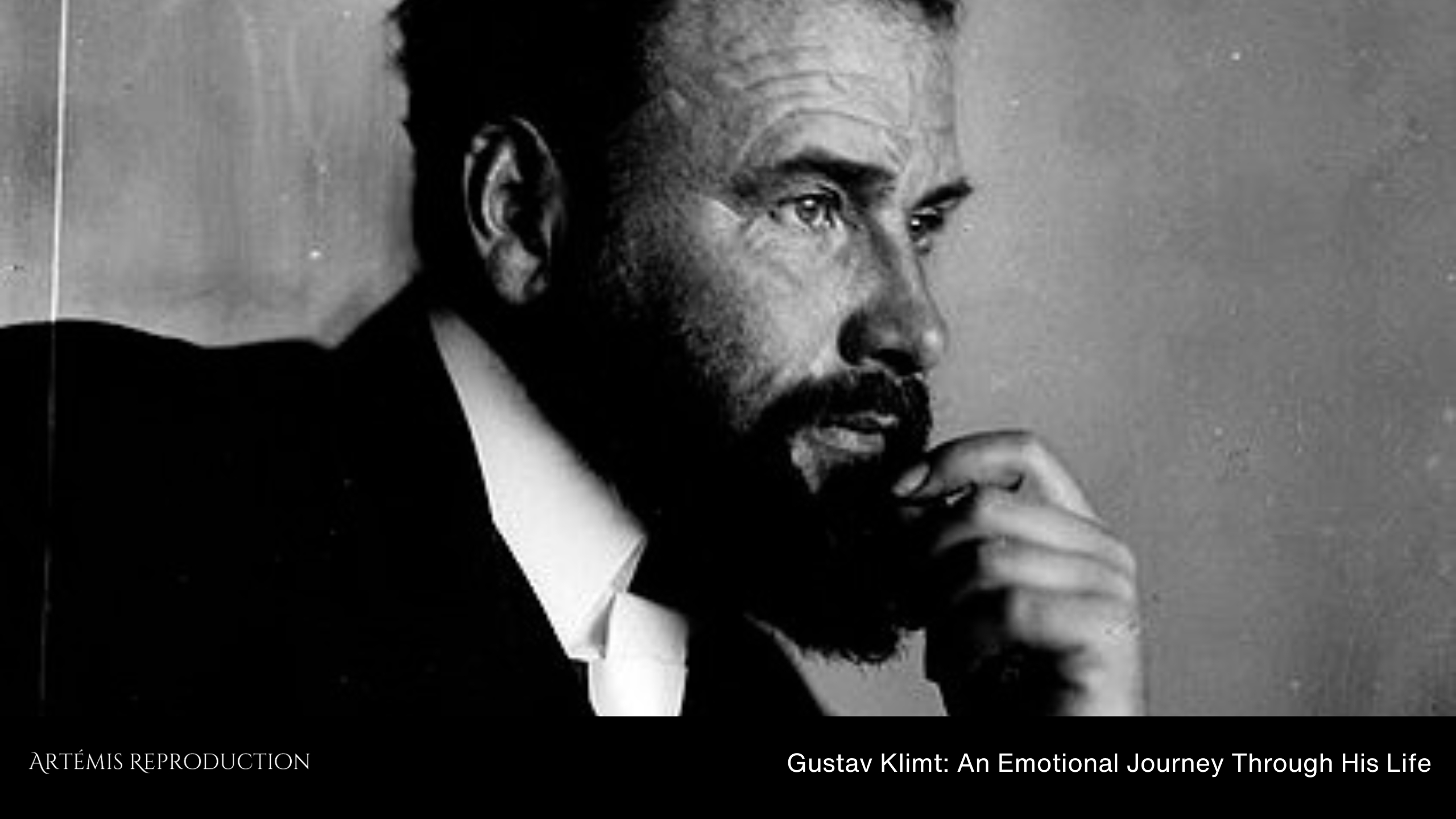
“The Artistic World of Gustav Klimt: A Biographical Introduction”
Gustav Klimt (1862-1918) was an iconic Austrian painter, celebrated as one of the greatest masters of the Art Nouveau movement. Born in Vienna, Austria, Klimt became a central figure in the Vienna Secession, a group of artists who revolutionized the European art scene at the end of the 19th and the beginning of the 20th century. His work is renowned for its bold use of gold, distinctive ornamental patterns, and symbolic depictions of sensuality and femininity. Through iconic pieces such as The Kiss and Portrait of Adele Bloch-Bauer I, Klimt left an indelible mark on art history, transcending academic conventions and introducing an innovative artistic style that continues to influence both modern and contemporary art.
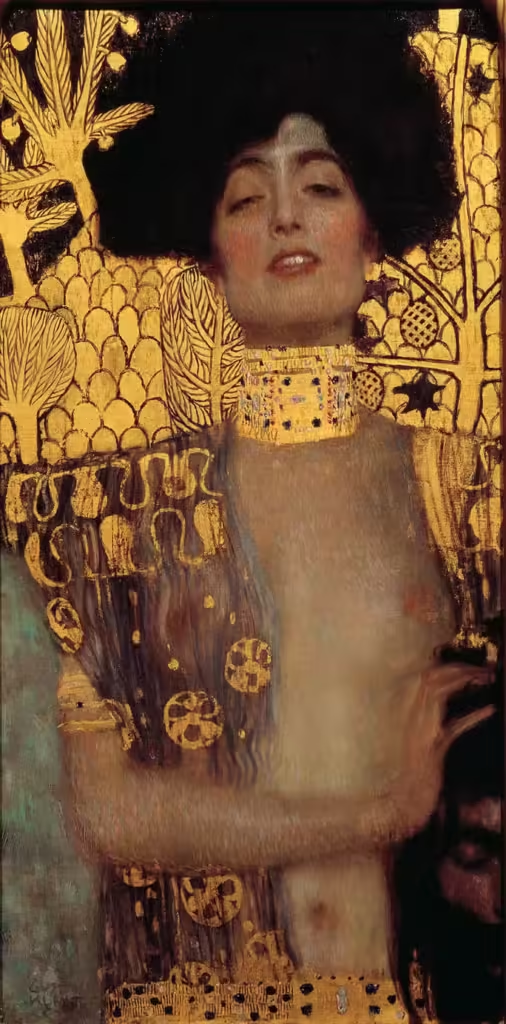
“The Formative Years: Gustav Klimt’s Youth and Education”
Birth and Childhood
Gustav Klimt was born on July 14, 1862, in Vienna, Austria, into a modest family. He was the second of seven children born to architect Ernst Klimt and his wife, Anna. From a young age, Klimt was exposed to the arts, thanks to his father, who nurtured his interest in drawing and painting. His family environment and the artistic influences of Vienna played a crucial role in the development of his early creative talents.
Artistic Education
At the age of fourteen, Klimt enrolled in the Vienna School of Arts and Crafts, where he received a rigorous academic training in drawing and painting. During his years of study, he stood out for his talent and his ability to incorporate decorative elements into his works. His early pieces were marked by a realistic style, influenced by the great masters of the past. However, it was in his later projects that he began to develop his distinctive style, characterized by rich ornamentation and an innovative use of gold and symbolic motifs. The education and collaborations at the school played a pivotal role in shaping his artistic approach, preparing him to become one of the leading figures of the Art Nouveau movement.

“First Steps: Navigating the Early Career Journey”
Initial Successes
Gustav Klimt’s early successes emerged during the 1880s when he began receiving commissions for decorative works. Among his first notable creations were the frescoes for the Kunsthistorisches Museum in Vienna, where he showcased his talent for mural compositions and the integration of decorative elements. In 1894, Klimt, along with his brother Ernst and his friend Franz Matsch, founded the Verein Bildender Künstler Wien (Vienna Association of Fine Artists), an artistic group focused on decorative projects for public buildings. These early works helped establish Klimt as an innovative and versatile artist, seamlessly blending art and architecture with elegance.
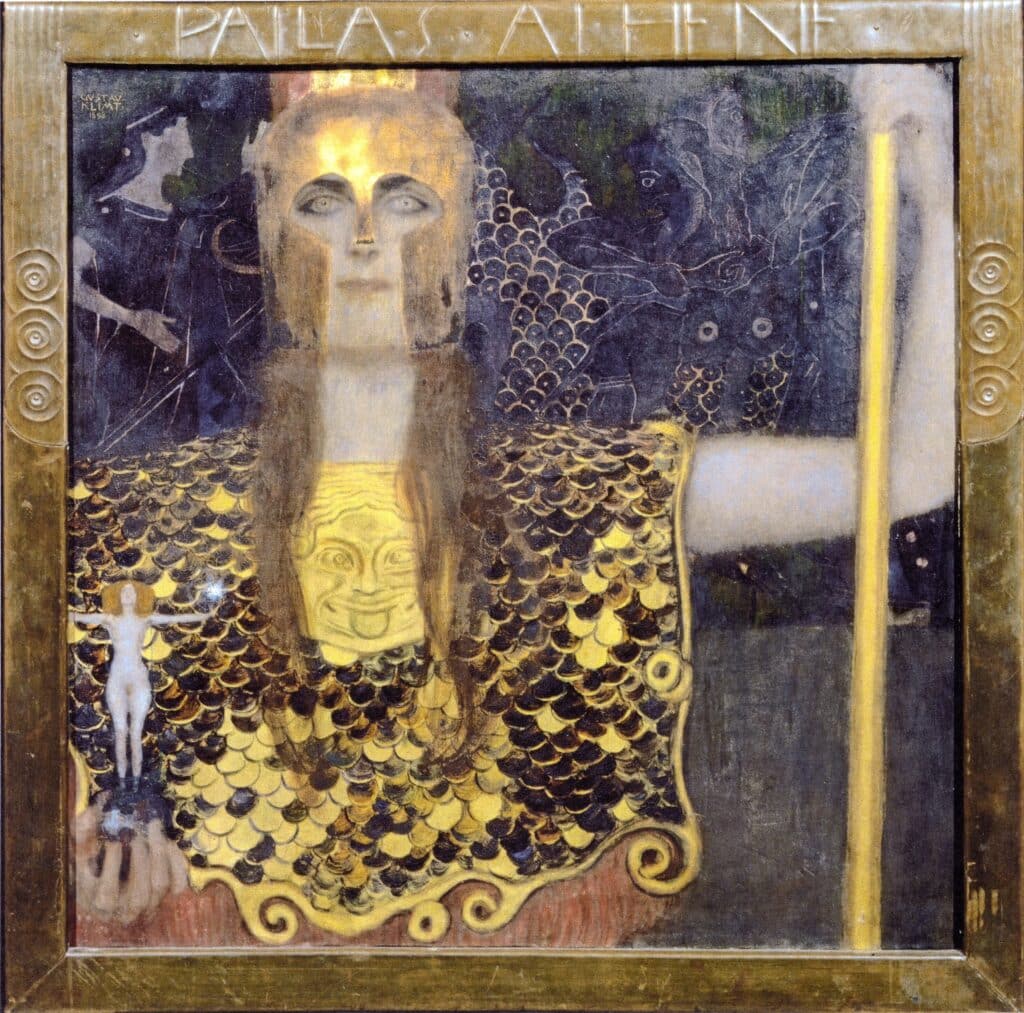
Collaboration and Evolution
During the 1890s, Klimt quickly evolved towards a more personal and distinctive style. His collaboration with his brother Ernst, with whom he worked on various decorative projects, as well as with Franz Matsch, marked a period of great creativity. Together, they produced works that combined rich ornamentation and symbolic motifs, foreshadowing Klimt’s unique style. It was also during this time that he began developing his characteristic approach, featuring innovative uses of gold and intricate decorative patterns. This period of collaboration was crucial to the maturation of his art, preparing him to become an iconic figure in the Art Nouveau movement.
Art Nouveau Period
Vienna Secession
In 1897, Klimt played a pivotal role in the creation of the Vienna Secession, an artistic movement aimed at breaking away from the academic conventions of the time. Alongside other avant-garde artists like Egon Schiele and Koloman Moser, he co-founded the Secession to promote a freer form of art, less constrained by established traditions. The movement was characterized by its desire to renew art through innovative forms and personal expression. As a leading member, Klimt helped transform the Secession into a major center of European artistic creativity, emphasizing aesthetic beauty and individual expression.
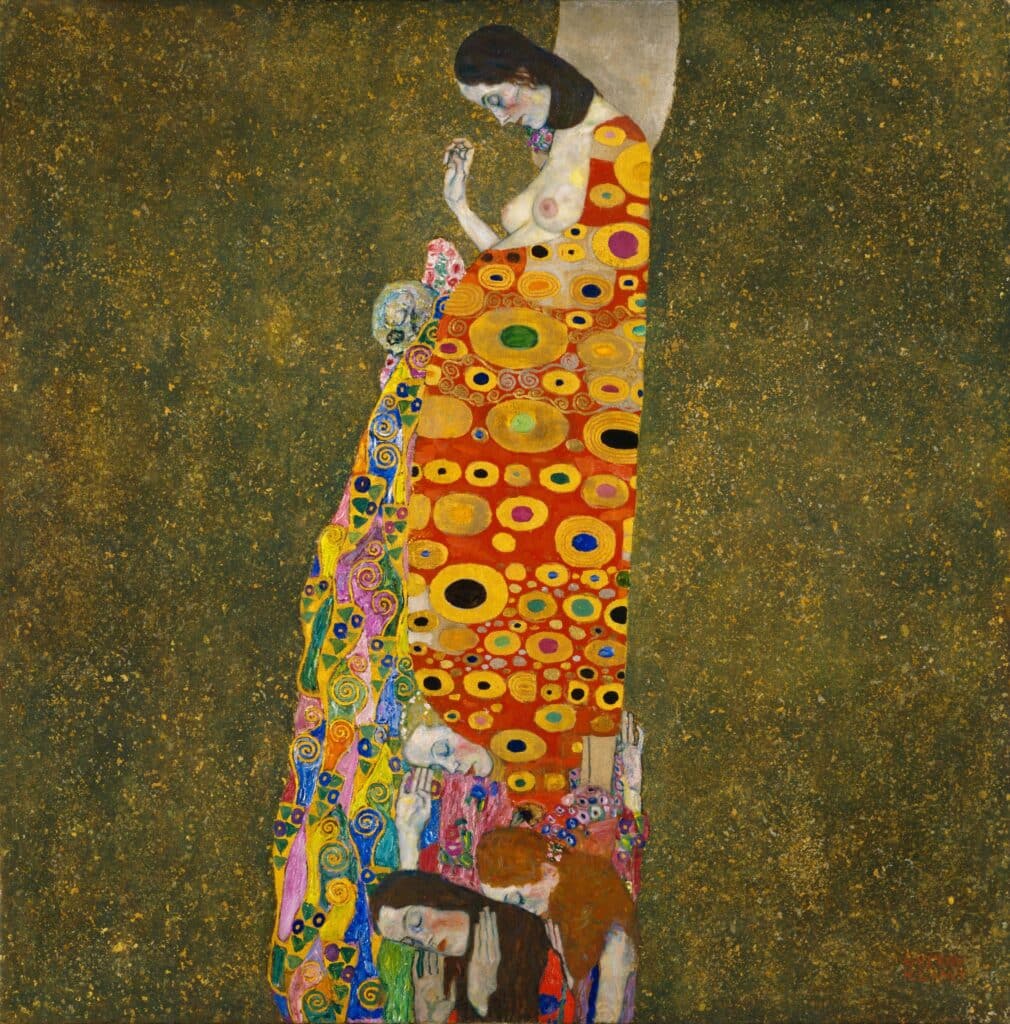
Style Characteristics
Klimt’s Art Nouveau period is particularly defined by his bold use of gold and decorative motifs. His works often incorporate elements inspired by Byzantine art and mythology, resulting in rich and detailed compositions. Klimt’s style is distinguished by his ability to blend ornamentation with symbolist themes, exploring concepts such as love, sensuality, and spirituality. Paintings like The Kiss and Portrait of Adele Bloch-Bauer I exemplify his unique approach, featuring vibrant colors, luxurious textures, and profound symbolism. These elements capture the essence of the Art Nouveau movement with unmatched sophistication.
“Gilded Elegance: The Iconic Artistry of Gustav Klimt”
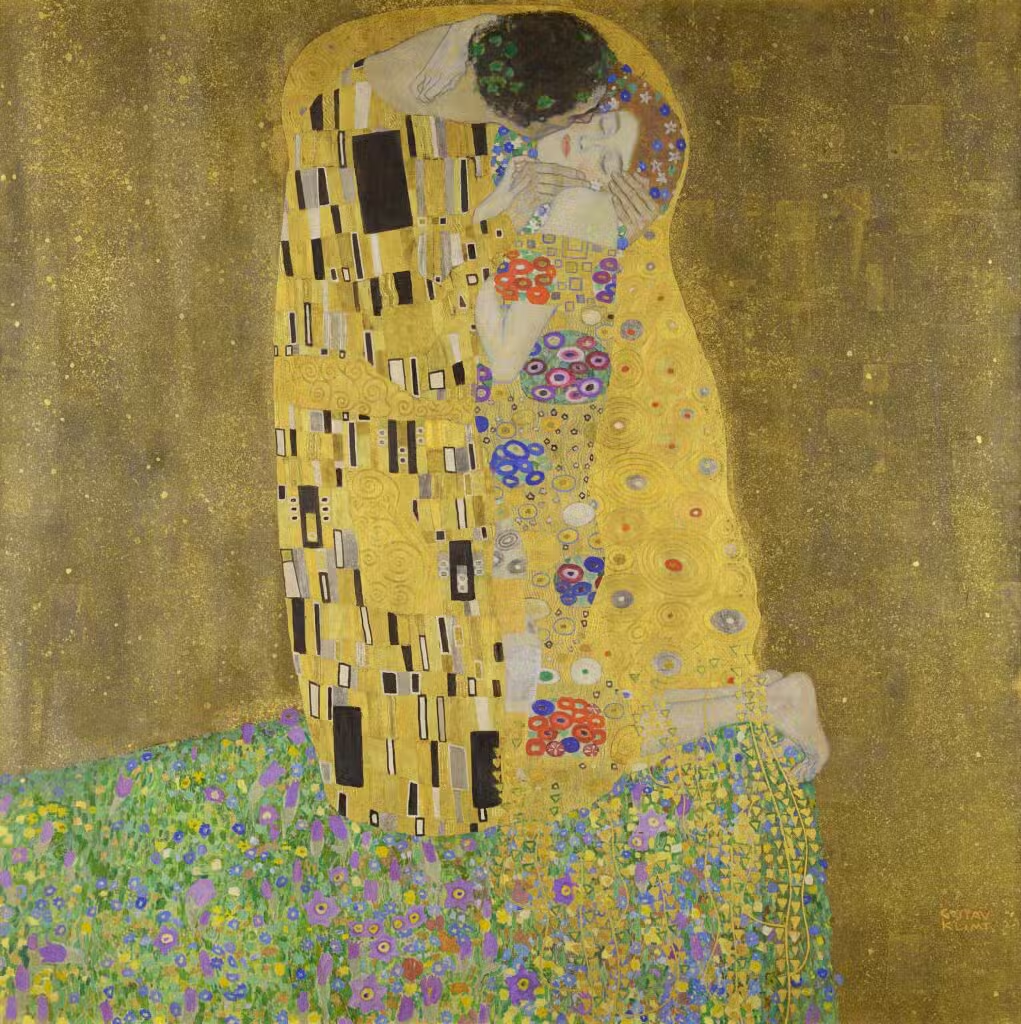
“The Kiss”
“The Kiss” (1907-1908) is undoubtedly Gustav Klimt’s most iconic work. This painting, depicting a couple locked in a passionate embrace, enveloped in gold and intricate patterns, perfectly embodies the artist’s Art Nouveau style. The piece is characterized by exceptional decorative richness, with the use of gold giving the scene an almost mystical quality. The symbolism of “The Kiss” goes beyond romantic love, delving into themes of spiritual transcendence and divine union. Its cultural impact is immense, making this work a 20th-century art icon, celebrated for its visual beauty and profound emotional resonance.

“Portrait of Adele Bloch-Bauer I”
“Portrait of Adele Bloch-Bauer I” (1907) is another of Klimt’s major works, renowned for its lavish use of gold and intricate patterns. This portrait of aristocrat Adele Bloch-Bauer is not only remarkable for its technique and style, but it has also been at the center of significant controversy. The painting exemplifies Klimt’s mastery in portraying beauty and elegance, while being imbued with symbolism. The piece was the subject of legal disputes, particularly due to its controversial restitution to the Bloch-Bauer family after World War II. This case garnered international attention, highlighting both the historical and aesthetic value of the work.
Other Key Works
“Judith I” (1901): This painting depicts the biblical figure of Judith, renowned for her sensuality and strength. Klimt combines symbolist and ornamental elements to create a work that is both provocative and majestic. It is an excellent example of Klimt’s style, blending decorative art with powerful storytelling.
“Nuda Veritas” (1899): In this provocative work, Klimt explores the concept of naked truth and beauty through a female figure presented in all her splendor. The painting highlights Klimt’s boldness in challenging artistic and social conventions, emphasizing raw beauty and critiquing the moral values of his time.
“The Influence and Impact of Gustav Klimt: Reactions and Controversies”
Contemporary Criticisms
At the time of their creation, Klimt’s works elicited mixed reactions. The Kiss and other paintings were criticized for their ornamental style, deemed too bold and distant from academic norms. The paintings commissioned for the University of Vienna, in particular, sparked controversy due to their erotic nature, leading to their rejection. These criticisms reflect the tensions between Klimt’s artistic innovation and the conservative expectations of his era.
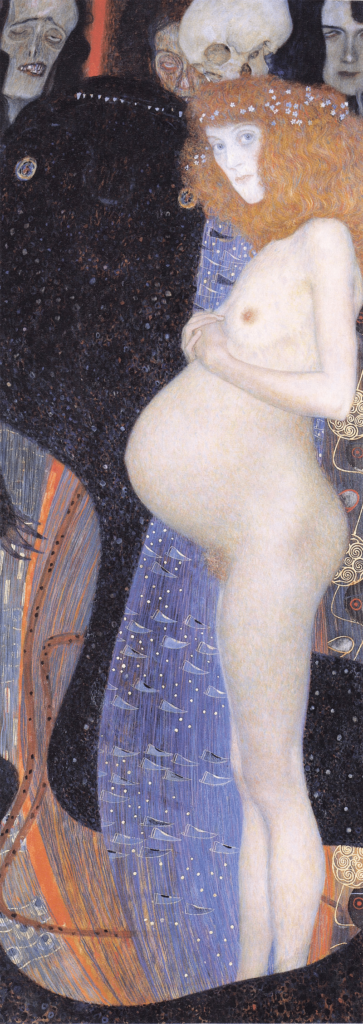
Posthumous Recognition
After his death in 1918, the perception of Klimt’s work underwent significant transformation. Over the decades, his creations have been recognized as masterpieces of Art Nouveau and Symbolism. Klimt’s works are now celebrated for their unique beauty and their contribution to the evolution of modern art. The successful restitution of paintings like Portrait of Adele Bloch-Bauer I has also heightened interest in his work, solidifying his status as an artistic icon and confirming the enduring impact of his oeuvre on the contemporary art world.
“Gustav Klimt: The Evolution and Legacy of an Artistic Pioneer”
Evolution of Style
In the later years of his career, Gustav Klimt underwent a significant stylistic evolution. After establishing his distinctive style during the Art Nouveau period, Klimt shifted towards a more expressive and modernist approach. His later works exhibit a bolder use of color and form, while still retaining the ornamental and symbolic elements that characterized his earlier creations. This transition is marked by a deeper exploration of subjectivity and emotion, influenced by emerging modernist currents. The move to a more expressive style reflects his commitment to pushing the boundaries of art and adapting to the aesthetic changes of his time.

“The Legacy of Gustav Klimt: His Final Masterpieces and Legacy”
Klimt’s final works, such as Portrait of Adele Bloch-Bauer I, demonstrate an artistic maturity and mastery of color and composition that continue to captivate. Despite declining health, Klimt continued to work passionately until his death. He passed away on February 6, 1918, in Vienna, leaving behind a substantial artistic legacy. His death marked the end of an era for Art Nouveau, but his influence endured, continuing to inspire generations of artists and art enthusiasts.
Legacy and Influence
Enduring Impact
Gustav Klimt’s legacy is profound and enduring. His work has had a significant influence on later artistic movements, including Expressionism and Surrealism. Klimt is celebrated for his ability to blend rich ornamentation with deep symbolism, inspiring many artists to explore emotional and psychological themes in their own artistic practices. His innovative techniques and distinctive style paved the way for a new approach to art, marking an important transition in the history of modern art.
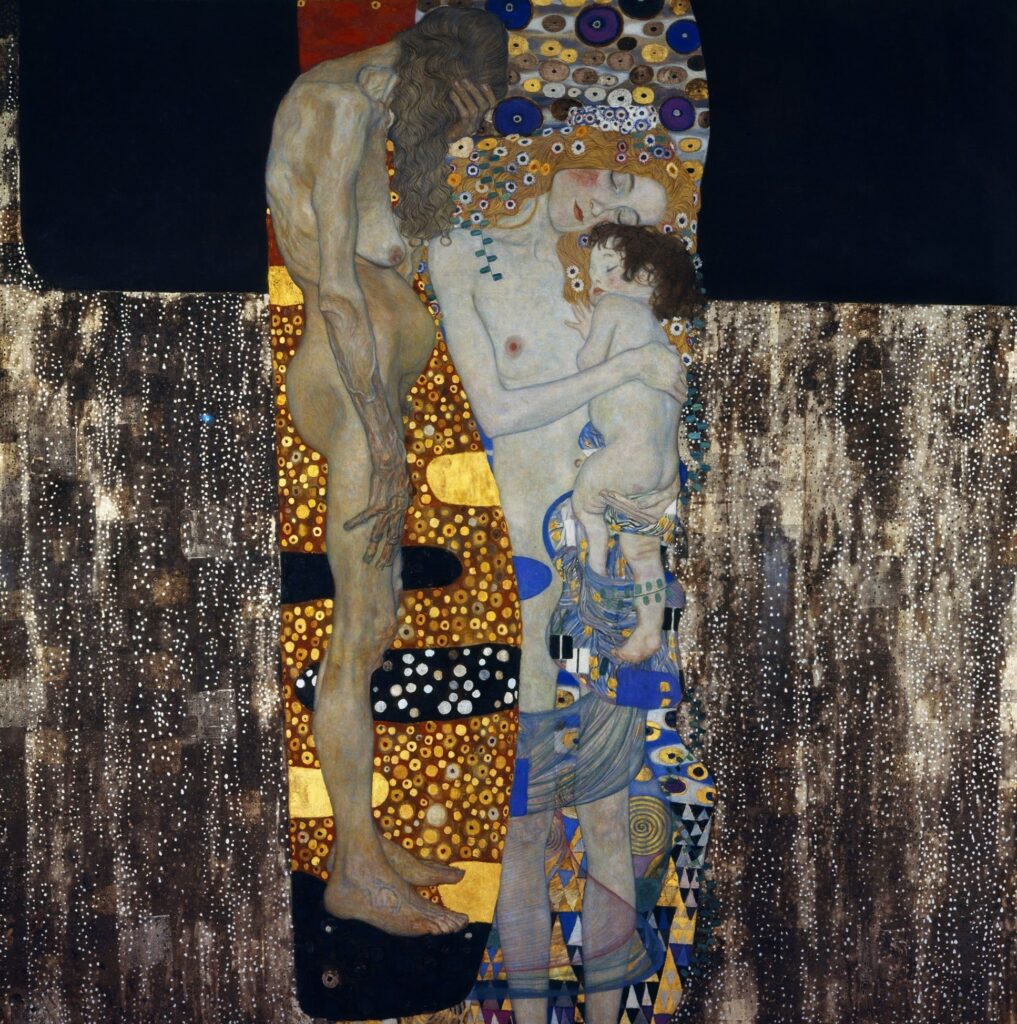
Popular Culture
Klimt’s impact also extends to popular culture. His works have become widely recognized visual references, appearing in various contemporary media and designs. The Kiss and other paintings have been reproduced on posters, decorative items, and even in advertising campaigns, highlighting their timeless appeal. Klimt has managed to transcend the art world to become an iconic figure in modern culture, demonstrating the ongoing power and relevance of his work.
“Gustav Klimt: A Legacy of Beauty and Controversy”
Summary of Impact
Gustav Klimt has left an indelible mark on the world of art and culture. As a pioneer of Art Nouveau, he transformed the way we perceive art through his innovative use of gold, decorative patterns, and symbolism. His impact extends beyond his era; he paved the way for future artistic movements such as Expressionism and Surrealism. Klimt’s works continue to be celebrated for their aesthetic richness and their ability to capture deep and complex emotions, solidifying his place as a pivotal figure in art history.
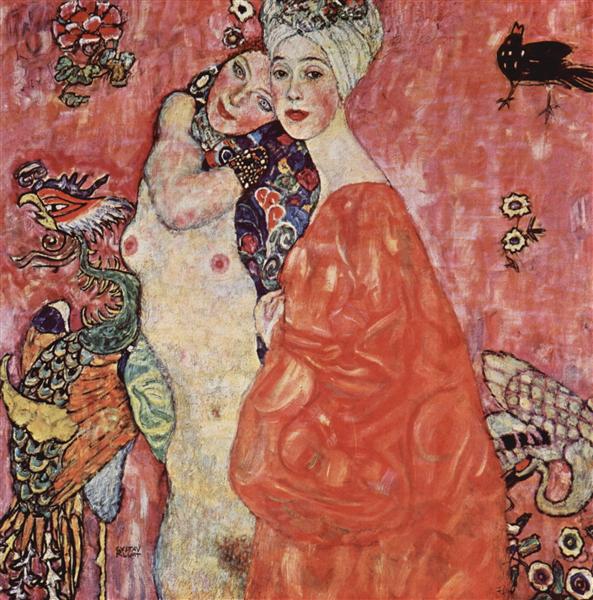
Invitation to Discover
We invite you to explore and appreciate Gustav Klimt’s works in all their splendor. Immerse yourself in his iconic creations such as The Kiss, Portrait of Adele Bloch-Bauer I, and Judith I, and be captivated by the depth and beauty of his art. Whether you are an art enthusiast or a newcomer, Klimt’s works offer an unparalleled visual and emotional experience. Delve into these masterpieces and let yourself be enchanted by the magic of his artistic universe.
For a complete experience, visit our online gallery’s dedicated Klimt collection. We have curated high-quality reproductions that will allow you to discover or rediscover the timeless magic and beauty of Klimt’s creations.

References and Resources
Sources for Further Information
To deepen your knowledge of Gustav Klimt and his work, here are some recommended books, articles, and websites:
Books:
- Gustav Klimt by Ralph J. Hargrove
- Klimt: The Complete Paintings by Susanna Partsch
- The World of Klimt by Christian Klemm
Articles:
- “Gustav Klimt: A Critical Overview” published in Art Journal
- “The Influence of Klimt on Modern Art” in Modern Art Perspectives
Websites:
- Klimt Foundation
- The Art Institute of Chicago – Gustav Klimt
- Museum of Modern Art – Klimt’s Works
These resources provide detailed and enriching insights into the life, work, and impact of Gustav Klimt, allowing you to explore the oeuvre of this Art Nouveau master more deeply.
Leave a Reply